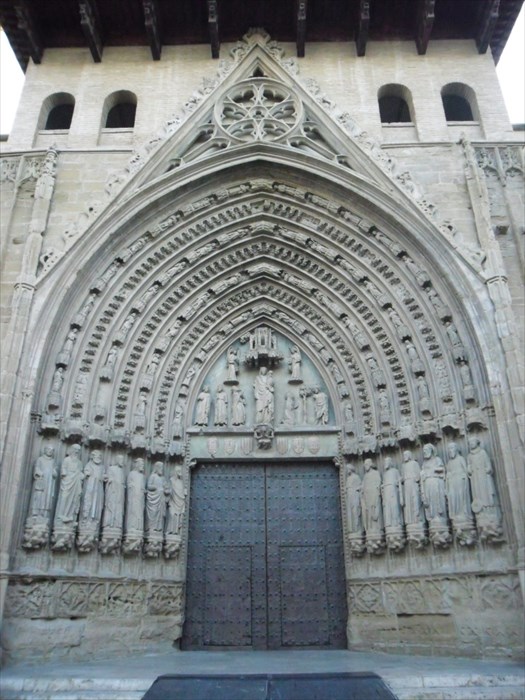-=:=-
Catedral de la Transfiguración del Señor
"The project of building the Cathedral of Huesca was initiated during the time of James I of Aragon (1213–1276), which is rather late when compared to other churches in the area, which date back to the Romanesque period. This is because in Huesca, Christian worship took place for almost two centuries in the mosque building, until the late 13th century. As the newly consecrated bishop of Huesca, the nephew of James I (James Sarroca), the king considered Christian worship in the mosque inappropriate. So in 1273, he proposed the building of a new gothic cathedral, which was on the increase in Europe, on top of the old mosque (of which just a horseshoe arch in the cloister area, which could have been used entry to the minaret tower of the mosque). But several lawsuits delayed the start of construction until 1294. The initial design proposed a construction of three naves, with five chapels at the front and a transept.
Situated next to the old mosque the Wasqah Taifa, it came up in the 12th century. The small Romanesque church dedicated to "Saint Mary of Joy". It comprises a frame with three archivolts: a segmented interior and external columns at the entrance. The innermost archivolt is decorated with Zamoran coils. Alight by a pair of two pairs of pilasters and chapels, with their corresponding shafts, with simple interior decoration. A part of the original Romanesque cloister is attached to the north side of the temple of which only the north and east bays and the southern part remain. The west bay was destroyed to build the Gothic cloister of Pope Luna, extending the south and north bays of the Romanesque.
The general design of the temple consists of a Latin cross with side chapels and three naves of four sections as well as the transept.
The front was built with five apses between 1294 and 1309. The north wall of the transept was also constructed, with its round-arched doorway the annexe, which was used for the vestry (the "Old Sacristy) and for archiving. Construction of the lateral naves took place between 1296 and 1304 Later he built the side chapels by his own initiative.
Between 1327 and 1348 the simple groin vaults in the side naves were put up and the central nave and the transept were covered with a wooden roof. The front of the cathedral, which is the work of the builder Guillem Inglés is an outstanding piece of Gothic sculpture. Consisting of seven archivolts that are home to sixteen figures, fourteen virgins, ten angels and eight prophets. The typanum is dominated by a statue of the Virgin and Child, and the sides by the Magi and the resurrected Christ with Mary Magdalene.
In the same period of the 15th century, thanks to the initiative of Pope Luna, Benedict XIII, part of a Gothic cloister was created, with the aim of restoring and replacing the old Romanesque one. The only part that was actually built was the corridor on the south side. The rest is now incomplete in what is now the Medieval Art Hall of the Cathedral Museum.
At the beginning of 1520, Damian Forment was commissioned to erect the cathedral's main altarpiece. Made of alabaster, the body is a large triptych of three scenes depicting the Passion of Christ."
From the wikipedia website: www.wikipedia.com
